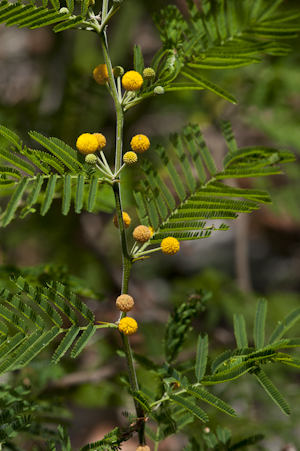Plants of South Florida · Plants by Conservation Area · Plants by County · Plants by Habitat Quick Search · Advanced Search |
||
|
|
||
 |
Vachellia macracantha (Humb. Porknut |
|
|
South Florida Status: Historical. Last reported in 1987 for the Florida Keys. Taxonomy: Dicotyledon; Fabaceae. Habit: Small tree. Distribution: Native to South Florida, the West Indies, and South America. South Florida Distribution: Native to the Monroe County Keys. Escaped from cultivation on the South Florida mainland and in Manatee County in central Florida. South Florida Habitats: Coastal berms and rockland hammocks. Protection Status: Not listed by any agency. Aids to Identification: Scurlock (1987) has color photos; Nelson (1994) has a color photo; Nelson (1996) has a photo. References: Ward, 1967; Isely, 1975; Long & Lakela, 1976; Little, 1978; Correll & Correll, 1982; Scurlock, 1987; Isely, 1990; Nelson, 1994; Nelson, 1996; Wunderlin, 1998; Liogier & Martorell, 2000. Synonyms: Acacia macracantha Humb. & Bonpl. ex Willd. Historical Context: Ellsworth P. Killip first collected porknut in 1952 on Vaca Key (42009, NY). George N. Avery also observed it on Vaca Key in 1966 in a rockland hammock. Only one tree was seen and it was apparently the same tree that was vouchered by Killip (Avery’s Notes, 6 March 1966). The Vaca Key tree was located just east of the Crane Point Hammock Museum, likely in what is now the museum property. Avery discovered porknut on Ramrod Key in 1963 (Avery’s Notes, 13 March 1963; Ward, 1967). Avery noted 15 plants on a coastal berm on the southwest portion of the island. A portion of this berm is privately owned and a portion is owned by Monroe County, but this site is apparently not designated as a conservation area. Scurlock (1987) reported that porknut was extant in the Florida Keys, but we have been unable to verify this report. Both the Crane Point Hammock and Ramrod Key stations need to be surveyed. Porknut has been cultivated in Florida and has sparingly naturalized in Miami-Dade (Isely, 1990) and Manatee counties (Wunderlin, 1998). As far as we are aware, germplasm of the South Florida plants was not conserved. Recommendations: · Survey Crane Point Hammock Museum Site and Ramrod Key Coastal Berm Site. · If plants are found, map and monitor known populations. · If no plants are found, assess appropriateness and study feasibility of reintroduction to Crane Point Hammock Museum Site and Ramrod Key Coastal Berm Site. · Acquire privately owned portion of Ramrod Key Coastal Berm Site, designate Monroe County-owned portion of Ramrod Key Coastal Berm Site as a conservation area, and develop conservation agreement with Crane Point Hammock Museum to restore and manage a viable population of porknut. · Review for listing by FDACS and FNAI. |
||



